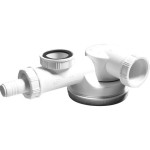Under Bathroom Sink Protector: Safeguarding Your Cabinet and Home
The space beneath a bathroom sink, often relegated to storing cleaning supplies and toiletries, is susceptible to significant water damage. Leaks, spills, and condensation can silently wreak havoc, leading to mold growth, structural deterioration, and costly repairs. An under bathroom sink protector is a proactive solution designed to mitigate these risks, offering a barrier against moisture and containing potential messes. This article will explore the benefits, types, installation process, and factors to consider when choosing an under bathroom sink protector.
Protecting Against Water Damage
The primary function of an under bathroom sink protector is to prevent water damage. Plumbing connections beneath the sink, including supply lines and drain pipes, are prone to leaks. A slow drip can go unnoticed for extended periods, saturating the cabinet base and creating a breeding ground for mold. Solid surface protectors, often made of plastic or metal, act as a waterproof shield, preventing water from reaching the cabinet structure. They also feature raised edges or lips to contain spills, providing ample time to identify and address the source of the leak before significant damage occurs.
Furthermore, condensation can accumulate on cold pipes, particularly during periods of high humidity. This condensation can drip onto the cabinet floor, leading to similar problems as direct leaks. Under bathroom sink protectors provide a barrier against this condensation, preventing it from seeping into the wood and causing deterioration. By preventing water from coming into contact with the cabinet material, the protector extends the life of the cabinetry and avoids costly replacements.
In addition to preventing structural damage, under sink protectors also prevent the growth of mold and mildew. These microorganisms thrive in damp environments, and a leaky cabinet is an ideal breeding ground. Mold can cause respiratory problems and other health issues, and its removal can be expensive and time-consuming. By keeping the under-sink area dry, these protectors inhibit mold growth, contributing to a healthier indoor environment.
An under bathroom sink protector can contain spills of cleaning products, toiletries, and other potentially harmful substances. Many of these products can stain or damage cabinet surfaces, and some may even pose a safety hazard. The protector's lipped design prevents these spills from spreading, making cleanup easier and minimizing the risk of damage to the cabinet and surrounding areas. This is particularly important in households with children or pets, where accidental spills are more likely.
Types of Under Bathroom Sink Protectors
The market offers a variety of under bathroom sink protectors, each with its own characteristics and suitability for different situations. Understanding the different types allows for an informed decision tailored to specific needs and cabinet dimensions.
Plastic Liners: These are typically the most affordable option. They are made from flexible plastic and can be easily cut to fit the specific dimensions of the under-sink area. Plastic liners are water-resistant but may not be as durable as other options. They can also be prone to sliding around if not properly secured.
Metal Trays: Metal trays, often made of stainless steel or coated aluminum, offer greater durability and a more robust barrier against water damage. They are typically more expensive than plastic liners but provide superior protection and a longer lifespan. Metal trays are also less likely to slide around due to their weight and rigidity.
Silicone Mats: Silicone mats provide a flexible and non-slip surface. They are resistant to water, chemicals, and stains, making them an excellent choice for protecting against spills and leaks. Silicone mats are often heat-resistant as well, providing an added layer of protection in case of accidental contact with hot items. They are easy to clean and maintain, making them a practical option for busy households.
Custom-Fit Protectors: For a more tailored solution, custom-fit protectors are available. These protectors are designed to precisely fit the dimensions of the under-sink area, providing a seamless and secure barrier against water damage. Custom-fit protectors may be made from various materials, including plastic, metal, or silicone, depending on the specific requirements. While they are generally more expensive than standard options, they offer the best level of protection and can significantly enhance the overall appearance of the under-sink area.
When choosing a type of protector, consider the material's resistance to chemicals, its ability to contain spills, and its overall durability. Also, factor in the ease of cleaning and maintenance. A protector that is easy to wipe down or remove for cleaning will help to maintain a sanitary and organized under-sink area.
Installation and Maintenance
Installing an under bathroom sink protector is generally a straightforward process that can be completed with minimal tools and effort. However, proper installation is crucial to ensure the protector functions effectively and provides adequate protection against water damage.
Preparation: The first step is to thoroughly clean the under-sink area. Remove all items and wipe down the surfaces to remove any dirt, dust, or debris. This will ensure a clean and smooth surface for the protector to adhere to. If there are any existing signs of water damage, such as mold or mildew, address these issues before installing the protector. Use a mold and mildew remover to thoroughly clean the affected areas and allow them to dry completely.
Measurement and Cutting: Measure the dimensions of the under-sink area to determine the appropriate size for the protector. If using a plastic liner or silicone mat, you may need to cut it to fit the specific dimensions of the cabinet. Use a sharp utility knife or scissors to carefully trim the protector, ensuring a snug fit. For metal trays, make sure to select a size that closely matches the dimensions of the under-sink area. Custom-fit protectors will already be pre-cut to the exact dimensions, eliminating the need for trimming.
Placement and Securing: Place the protector into the under-sink area, ensuring that it is properly aligned and covers the entire base of the cabinet. For plastic liners and silicone mats, consider using double-sided tape or adhesive to secure the protector in place and prevent it from sliding around. Apply the tape to the edges and corners of the protector and press it firmly onto the cabinet surface. For metal trays, the weight of the tray itself may be sufficient to keep it in place. However, if desired, you can also use adhesive to secure it further.
Maintenance: Once installed, the under bathroom sink protector requires minimal maintenance. Regularly inspect the area for any signs of leaks or spills. If any spills occur, promptly clean them up with a damp cloth or sponge. Occasionally remove the protector to clean underneath and check for any hidden moisture or damage. This will help to ensure that the under-sink area remains clean, dry, and free from mold and mildew. Avoid using harsh chemicals or abrasive cleaners, as these can damage the protector's surface. Instead, use a mild soap and water solution to clean the protector.
Regular inspection of plumbing connections under the sink is also critical. Check for drips or dampness around supply lines, drain pipes, and faucet connections. Addressing these issues promptly can prevent major water damage and ensure the effectiveness of the under bathroom sink protector.
Choosing the right under bathroom sink protector involves considering several factors, including the size and layout of the under-sink area, the type of plumbing fixtures, and the desired level of protection. Before making a purchase, measure the dimensions of the under-sink area to ensure that the protector will fit properly. Consider the material of the protector and its resistance to water, chemicals, and stains. Also, factor in the ease of installation and maintenance. A protector that is easy to install, clean, and maintain will provide long-lasting protection and peace of mind.
Investing in an under bathroom sink protector is a cost-effective way to protect your cabinets and home from the damaging effects of water. By preventing leaks, spills, and condensation, these protectors can extend the life of your cabinetry, prevent mold growth, and contribute to a healthier indoor environment. With a variety of types and sizes available, there is an under bathroom sink protector to suit every need and budget.

Norboe Gray Silicone Under Sink Mat For Kitchen Bathroom And Laundry Room 34 X 22 Com

Xtreme Mats Waterproof Under Sink Mat For Bathroom Pick Your Size 25 1 4 X 19 Cabinet Shelf Protector Flexible Drip Tr In 2024

Rubber Sink Mat Kitchen Bathroom

Under Sink Mat 34 X 22 Mats For Kitchen Waterproof Silicone Liner Drip Tray With Drain Hole Cabinet Bathroom Grey Com

Under Sink Mat Water Resistant Silicone Drip Tray Shelf Liner For Kitchen Bathroom 34 In X 22 Com

Norboe Gray Silicone Under Sink Mat For Kitchen Bathroom And Laundry Room 34 X 22 Com

Weathertech Sinkmat Under Bathroom Vanity Sink Cabinet Protection Mats Usm02 28 3 8 X 19 7 Made In The Usa
Under Sink Mat Kitchen Cabinet Tray 34 X 22 Silicone Waterproof Liners For Protector Water Drips Leaks Spills Holds Over 3 Gallons Black Com

Sink Topper Cover For Bathroom Counter Spaces Organizer Makeup Mat Black Large Com

Weathertech Sinkmat Under Bathroom Vanity Sink Cabinet Protection Mats Usm02 28 3 8 X 19 7 Made In The Usa







